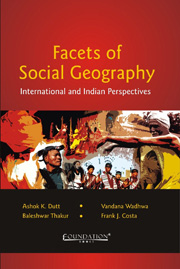Book contents
- Frontmatter
- Contents
- Foreword
- Preface
- Acknowledgements
- List of Contributors
- I Introductory Framework: Allen G. Noble's Contribution to Social Geography
- II Conceptual and Theoretical Basis of Social Geography
- III Social Geography from a Global Perspective
- IV Social Geography in the Indian Context
- V Indian Social Geography: City and State Context
- 24 Health Infrastructure and Healthcare Services in Uttar Pradesh
- 25 Status of Women in Aligarh Muslim University, India
- 26 Social Geographies of Collective Action: A Case Study of India's Chipko Movement
- 27 Sacredscape and Manescape: The Sacred Geography of Gaya, India
- 28 Madurai: A Holy City of Pilgrimage
- 29 Assessment and Dynamics of Urban Growth in the City of Kolkata
- 30 Socioeconomic and Demographic Conditions of the Slums of Hyderabad
- 31 Writings of Mirza Ghalib: A Study in Literary Geography
- 32 Geographic Images of Old Delhi through Literature
- 33 Spatial and Temporal Characteristics of Elite Residential Colonies in Delhi, 1982–2004
- Index
29 - Assessment and Dynamics of Urban Growth in the City of Kolkata
from V - Indian Social Geography: City and State Context
Published online by Cambridge University Press: 05 June 2012
- Frontmatter
- Contents
- Foreword
- Preface
- Acknowledgements
- List of Contributors
- I Introductory Framework: Allen G. Noble's Contribution to Social Geography
- II Conceptual and Theoretical Basis of Social Geography
- III Social Geography from a Global Perspective
- IV Social Geography in the Indian Context
- V Indian Social Geography: City and State Context
- 24 Health Infrastructure and Healthcare Services in Uttar Pradesh
- 25 Status of Women in Aligarh Muslim University, India
- 26 Social Geographies of Collective Action: A Case Study of India's Chipko Movement
- 27 Sacredscape and Manescape: The Sacred Geography of Gaya, India
- 28 Madurai: A Holy City of Pilgrimage
- 29 Assessment and Dynamics of Urban Growth in the City of Kolkata
- 30 Socioeconomic and Demographic Conditions of the Slums of Hyderabad
- 31 Writings of Mirza Ghalib: A Study in Literary Geography
- 32 Geographic Images of Old Delhi through Literature
- 33 Spatial and Temporal Characteristics of Elite Residential Colonies in Delhi, 1982–2004
- Index
Summary
The world has seen, and is still seeing the rapid development and spread of urban areas. Cities and towns have sprouted up every where around the globe. Villages are transforming into towns and towns into cities, attracting more and more people, and adding to urban expansion. Population increase and industrialization are the key factor behind such a phenomenal change in spatial structure.
India, the second most populated country in the world, has experienced large-scale development in and around its urban areas. The city of Kolkata (formerly Calcutta until 2001) in eastern India, the focus herein, has being aggressively multiplying in size over the last three decades. However, the rea population explosion took place between 1940 and 1950, during the Indian independence phase, although growth as such is still continuing (Chakraborty, 1990).
Closely associated with the morphology of any city are its past and present populations that have adhered to certain social and economic customs and followed distinctive occupations (Dutt et al., 1989, 151) Kolkata was the first major city developed by the British East India Company in the early 1700s. The East India Company built their first fortified construction, Fort William, to protect them from the other colonia aspirants. It was around this same fortified structure that the city of Kolkata grew and nurtured itself. It was a garrison town first, then the Company's town, next a provincial city, and later the headquarters of the British India government (National Atlas and Thematic Mapping Organisation (NATMO), 1996).
- Type
- Chapter
- Information
- Facets of Social GeographyInternational and Indian Perspectives, pp. 541 - 555Publisher: Foundation BooksPrint publication year: 2012
- 3
- Cited by

